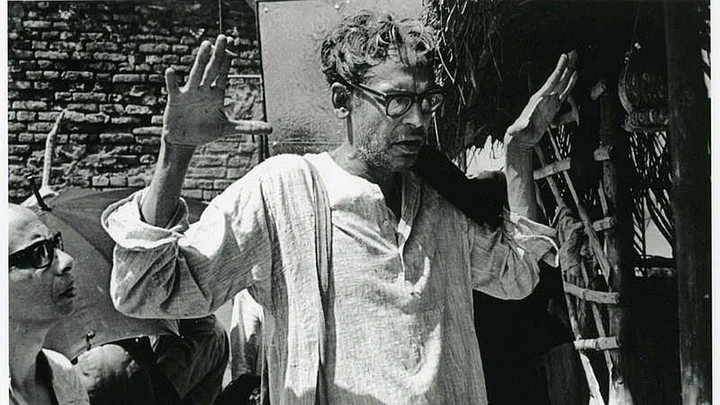Ritwik Ghatak and his cinema remains highly admired in cinema circles, but that’s also where he stays restricted. And that’s a travesty. Because for the young, he can be a figure who can bring the possibilities of reason and debate into a cinematic discourse, and break the shackles of opportunism in moving images.
Here’s a feeble attempt to tell our young readers why Ghatak matters.
1. He Can Give You a Different Impetus to Make Films
Ghatak never made films for money, and he wished to make cinema an important tool of mass media that could serve far-reaching goals of change.
He said, “I make films for people. Sergei Eisenstein and Vsevolod Pudovkin too did the same. We have to make cinema reach the hearts of common people. If we take vans to villages and exhibit cinema, it would be possible. In Bengal, women are used to watching jatra (musical plays). There was a time when religious lessons were taught through these plays. We have to master the art of these plays, and create characters that can understand the nerve of ordinary people. If we show films about family planning or government propaganda, the art of cinema will never evolve. Tell me, can you teach poems in school? Through mobile vans, cinema can not only be popular but also be widespread. I’ve tried to spot the usual rhyme of life in my films.”
I don’t wish to make money by making films. Immediate success is not the final aim of cinema. Which film will yield money, which will not, you can’t find a doctor for that. I am making films for my people. I believe in fight. Art means war.Ritwik Ghatak
2. He Inspires the Filmmakers You Admire
In all probability, the directors you swear by also swear by Ghatak. He has inspired countless distinguished filmmakers like Saeed Akhtar Mirza, Adoor Gopalakrishnan, Girish Kasaravalli, John Abraham, Jahnu Barua, Kumar Shahani, Mani Kaul, Ketan Mehta, Mira Nair etc in the arthouse space to mainstream directors like Subhash Ghai, Anurag Basu and Sanjay Leela Bhansali among others.
His filmography, his ideas and theories have been a potent stimulus for directors wielding the megaphone, add to that, his tenure at the Film and Television Institute of India (FTII) which turned him into an influential figure that all the students of the institute of past and present adore and admire. So, now you know, who is the master.
3. He Wrote One of Hindi Cinema’s Most Influential Reincarnation Dramas: Madhumati
Though he believed in cinema as a device to bring social change, and not a profit-making idea, he achieved his biggest commercial success in a Hindi film as a writer. Madhumati (1958), directed by Bimal Roy, and featuring Dilip Kumar, Vyjayantimala, Pran and Johnny Walker, was one of the earliest reincarnation dramas that inspired multiple films such as Karz (1980) and Om Shanti Om (2007) and even a Hollywood film, The Reincarnation of Peter Proud (1975).
Ghatak was disillusioned by the Bombay film industry and went back to Calcutta to make his kind of films, but Madhumati remains the aide-mémoire of the promises of him in mainstream cinema.
4. He is the Only One Who Can Rival Satyajit Ray’s Position as the Greatest Indian Filmmaker
From his debut at Cannes with Pather Panchali (1955) to the Academy Honorary Award in 1992, Satyajit Ray has been widely hailed as the greatest Indian filmmaker in India and abroad. Unlike Ray, Ghatak has been unlucky, and his fandom is restricted mostly in India. However, the scene is gently changing with swelling availability of his work with up-and-coming retrospectives.
The internet boom has only augmented his films being shared by cinephiles across the world. As a result, critics, filmmakers and audiences are getting increasingly aware of another cinematic titan in India’s cinematic universe. Ray’s position as the principal representational figure of Indian cinema in filmic discourses is getting challenged, and Ghatak is gradually emerging as an alternative.
Interestingly, both Ghatak and Ray admired each other’s work, the latter saidof the former, “Ritwik was one of the few truly original talents in the cinema this country has produced. […] As a creator of powerful images in an epic style he was virtually unsurpassed in Indian cinema.”
5. He is Original, Distinctive and Apt-to-be-talked-about
As a filmmaker and a creativeforce, Ritwik Ghatak was a man who extended the idea of cinema-literature into a modernist expression of beauty. He reinvented cinema with philosophical attitude, political ideas, and a heart that longed for larger social good.
He never shied away from the Indian tradition of melodrama, instead embraced it with a heightened sense of realism. His use of sound was exceptional, with ways of correlating images and sounds, and unanticipated breaches in mood and tone. He challenged the film form to understand the ideas of exile, and an investigation into the folk traditions that emerge out of cultural disintegration, making sweeping epics of the human condition.
He stands at the confluence of tradition and avant-gardism, and continues to be a name that inspires envy and debate in equal measure. He is Indian cinema’s true enfant terrible.
(The writer is a journalist and a screenwriter who believes in the insanity of words, in print or otherwise. Follow him on Twitter: @RanjibMazumder)
(This story is from The Quint’s archives and was first published on 6 February 2016. It is being republished to mark Ritwik Ghatak’s birth anniversary.)
(At The Quint, we question everything. Play an active role in shaping our journalism by becoming a member today.)
